Key Controlling Factors and Sources of Water Quality in Agricultural Rivers: A Study on the Water Source Area for the South-to-North Water Transfer Project
Abstract
1. Introduction
2. Materials and Methods
2.1. Description of the Study Region
2.2. Specimen Collection and Testing
2.2.1. Specimen Collection Strategy
2.2.2. Analysis of Water Chemistry
2.3. Data Analytics
2.3.1. Water Quality Index (WQI)
2.3.2. Statistical Analysis
3. Result
3.1. The Hydrochemical Characteristics of Jinqian River
3.2. Evaluation of Water Quality in the Jinqian River
3.3. The Hydrochemical Type of the Jinqian River
4. Discussion
4.1. The Temporal and Spatial Variations of Water Quality in the Jinqian River
4.2. Identification of Hydrochemical Component Sources in Agricultural Rivers
4.3. The Impact of Human Activities on Agricultural Rivers
4.4. Source Apportionment of Pollution in Agricultural Rivers
5. Research Limitations and Future Prospects
6. Research Recommendations
- (1)
- Optimize Fertilizer Management
- (2)
- Upgrade Domestic Wastewater Treatment
- (3)
- Strengthen long-term monitoring and assessment
7. Conclusions
Supplementary Materials
Author Contributions
Funding
Data Availability Statement
Acknowledgments
Conflicts of Interest
References
- Zhang, Q. Water quality assessment of river basins: New insights and practical solutions. Water 2025, 17, 1207. [Google Scholar] [CrossRef]
- Li, S.; Gu, S.; Liu, W.; Han, H.; Zhang, Q. Water quality in relation to the landuse and land cover in the upper Han River basin, China. Catena 2008, 75, 216–222. [Google Scholar] [CrossRef]
- Zhang, Q.; Liu, W.; Sun, H.; Wang, H.; Wang, L.; Zhang, J.; Xu, Z. Cascade reservoir regulations on nitrogen source and transformation in the Tibetan Plateau river: Constraints from high frequency data of Lancang River. J. Hydrol. 2025, 650, 132563. [Google Scholar] [CrossRef]
- Liu, W.; Jiang, H.; Zhang, J.; Xu, Z. Driving forces of nitrogen cycling and the climate feedback loops in the Yarlung Tsangpo River Basin, the highest-altitude large river basin in the world. J. Hydrol. 2022, 610, 127974. [Google Scholar] [CrossRef]
- Gandhimathi, G.; Chellaswamy, C.; Thiruvalar, S.P. Comprehensive river water quality monitoring using convolutional neural networks and gated recurrent units: A case study along the Vaigai River. J. Environ. Manag. 2024, 365, 121567. [Google Scholar] [CrossRef]
- Mustapha, A.; Aris, A.Z.; Juahir, H.; Ramli, M.F.; Kura, N.U. River water quality assessment using environmetric techniques: Case study of Jakara River Basin. Environ. Sci. Pollut. Res. 2013, 20, 5630–5644. [Google Scholar] [CrossRef]
- Zhao, Z.Y.; Zuo, J.; Zillante, G. Transformation of water resource management: A case study of the South-to-North Water Diversion project. J. Clean. Prod. 2017, 163, 136–145. [Google Scholar] [CrossRef]
- Zhang, Q. The South-to-North Water Transfer Project of China: Environmental implications and monitoring strategy. J. Am. Water Resour. Assoc. 2009, 45, 1238–1247. [Google Scholar] [CrossRef]
- Liu, J.; Han, G.; Liu, M.; Zeng, J.; Liang, B.; Qu, R. Distribution, sources and water quality evaluation of the riverine solutes: A case study in the Lancangjiang River Basin, Tibetan Plateau. Int. J. Environ. Res. Public Health 2019, 16, 4670. [Google Scholar] [CrossRef] [PubMed]
- Mbaye, M.L.; Gaye, A.T.; Spitzy, A.; Dähnke, K.; Gaye, B. Seasonal and spatial variation in suspended matter, organic carbon, nitrogen, and nutrient concentrations of the Senegal River in West Africa. Limnologica 2016, 57, 1–13. [Google Scholar] [CrossRef]
- Jiang, H.; Liu, W.; Li, Y.; Zhang, J.; Xu, Z. Multiple isotopes reveal a hydrology dominated control on the nitrogen cycling in the Nujiang River basin, the last undammed large river basin on the Tibetan Plateau. Environ. Sci. Technol. 2022, 56, 4610–4619. [Google Scholar] [CrossRef]
- Li, Y.; Tu, Y.; Sun, T.; Duan, Y.; Kou, J.; Li, W.; Gao, J. Source apportionment of organic carbon and nitrogen in sediments from river and lake in the highly urbanized Changjiang Delta. J. Hazard. Mater. 2024, 478, 135590. [Google Scholar] [CrossRef]
- Xue, D.; Botte, J.; Baets, B.D.; Accoe, F.; Nestler, A.; Taylor, P.; Boeckx, P. Present limitations and future prospects of stable isotope methods for nitrate source identification in surface and groundwater. Water Res. 2009, 43, 1159–1170. [Google Scholar] [CrossRef] [PubMed]
- Tian, J.; Yuan, Z.; Mao, X.; Ma, T. Quantifying natural and anthropogenic impacts on riverine total nitrogen concentration and load in the Yellow River Basin. Environ. Pollut. 2025, 382, 126641. [Google Scholar] [CrossRef]
- Xu, Y.; Liu, W.; Xu, B.; Xu, Z. Riverine sulfate sources and behaviors in arid environment, Northwest China: Constraints from sulfur and oxygen isotopes. J. Environ. Sci. 2024, 137, 716–731. [Google Scholar] [CrossRef]
- GB3838-2002; Environmental Quality Standards for Surface Water. State Environment Protection Bureau of China: Beijing, China, 2002.
- WHO (World Health Organization). Guidelines for Drinking-Water Quality, 4th ed.; World Health Organization: Geneva, Switzerland, 2017. [Google Scholar]
- Popa, P.; Murariu, G.; Timofti, M.; Georgescu, L.P. Multivariate statistical analyses of water quality of danube river at galati, romania. Environ. Eng. Manag. J. 2018, 17, 1249–1266. [Google Scholar]
- Esquivel-Hernández, G.; Sanchez-Murillo, R.; Villalobos-Córdoba, D.; Monteiro, L.R.; Villalobos-Forbes, M.; Sánchez-Gutiérrez, R.; Matiatos, I. Exploring the acid neutralizing effect in rainwater collected at a tropical urban area: Central Valley, Costa Rica. Atmos. Pollut. Res. 2023, 14, 101845. [Google Scholar] [CrossRef]
- Ren, C.; Liu, L. Under the strong influence of human activities: The patterns and controlling factors of river water chemistry changes—A case study of the lower Yellow River. Water 2024, 16, 1886. [Google Scholar] [CrossRef]
- Jiang, H.; Zhang, Q.; Liu, W.; Zhang, J.; Zhao, T.; Xu, Z. Climatic and anthropogenic driving forces of the nitrogen cycling in a subtropical river basin. Environ. Res. 2021, 194, 110721. [Google Scholar] [CrossRef] [PubMed]
- Pant, R.R.; Zhang, F.A.; Rehman, F.U.; Wang, G.; Ye, M.; Zeng, C. Spatiotemporal variations of hydrogeochemistry and its controlling factors in the Gandaki River Basin, Central Himalaya Nepal. Sci. Total Environ. 2017, 622–623, 770–782. [Google Scholar] [CrossRef]
- Niu, C.; Zhang, Q.; Xiao, L.; Wang, H. Spatiotemporal variation in groundwater quality and source apportionment along the Ye River of North China using the PMF model. Int. J. Environ. Res. Public Health 2022, 19, 1779. [Google Scholar] [CrossRef]
- Fu, C.C.; Li, X.Q.; Ma, J.F.; Ling, X.L.; Ming, G.; Zhan, X.B. A hydrochemistry and multi-isotopic study of groundwater origin and hydrochemical evolution in the middle reaches of the Kuye River basin. Appl. Geochem. 2018, 98, 82–93. [Google Scholar] [CrossRef]
- Xing, J.; Long, W.; Jie, Z.; Tian, L. Hydrochemical variation characteristics and driving factors of surface water in arid areas—A case study of Beichuan River in Northwest China. Front. Environ. Sci. 2024, 12, 1493390. [Google Scholar] [CrossRef]
- Ye, H.; Han, Z.; Wu, P.; Zha, X.; Li, X.; Hou, E.; Peñuelas, J. Disentangling sources and transformation mechanisms of nitrogen, sulfate, and carbon in water of a Karst Critical Zone. Sci. Total Environ. 2024, 922, 171310. [Google Scholar] [CrossRef] [PubMed]
- Zhang, Q.; Sun, J.; Liu, J.; Huang, G.; Lu, C.; Zhang, Y. Driving mechanism and sources of groundwater nitrate contamination in the rapidly urbanized region of South China. J. Contam. Hydrol. 2015, 182, 221–230. [Google Scholar] [CrossRef] [PubMed]
- Liu, C.; Li, S.; Lang, Y.; Xiao, H. Using δ15N- and δ18O-values to identify nitrate sources in Karst groundwater, Guiyang, Southwest China. Environ. Sci. Technol. 2006, 40, 6928–6933. [Google Scholar] [CrossRef]
- Yue, F.J.; Liu, C.Q.; Li, S.L.; Zhao, Z.Q.; Liu, X.L.; Ding, H. Analysis of δ15N and δ18O to identify nitrate sources and transformations in Songhua River, Northeast China. J. Hydrol. 2014, 519, 329–339. [Google Scholar] [CrossRef]
- Meghdadi, A.; Javar, N. Quantification of spatial and seasonal variations in the proportional contribution of nitrate sources using a multi-isotope approach and Bayesian isotope mixing model. Environ. Pollut. 2018, 235, 207–222. [Google Scholar] [CrossRef]
- Jiang, H.; Liu, W.; Zhang, J.; Zhou, L.; Zhou, X.; Pan, K.; Zhao, T.; Wang, Y.; Xu, Z. Spatiotemporal variations of nitrate sources and dynamics in a typical agricultural riverine system under monsoon climate. J. Environ. Sci. 2020, 93, 98–108. [Google Scholar] [CrossRef]
- Wang, X.; Liu, Z.; Xu, Y.J.; Mao, B.; Jia, S.; Wang, C.; Ji, X.; Lv, Q. Revealing nitrate sources seasonal difference between groundwater and surface water in China’s largest fresh water lake (Poyang Lake): Insights from sources proportion, dynamic evolution and driving forces. Sci. Total Environ. 2025, 958, 178134. [Google Scholar] [CrossRef] [PubMed]
- Zhao, X.; Xu, H.; Kang, L.; Zhu, G.; Paerl, H.W.; Li, H.; Liu, M.; Zhu, M.; Zou, W.; Qin, B.; et al. Nitrate sources and transformations in a river-reservoir system: Response to extreme flooding and various land use. J. Hydrol. 2024, 638, 131491. [Google Scholar] [CrossRef]
- Iqbal, J.; Su, C.; Abbas, H.; Jiang, J.; Han, Z.; Baloch, M.Y.J.; Xie, X. Prediction of nitrate concentration and the impact of land use types on groundwater in the Nansi Lake Basin. J. Hazard. Mater. 2025, 487, 137185. [Google Scholar] [CrossRef]
- Qin, R.; Wu, Y.; Xu, Z.; Xie, D.; Zhang, C. Assessing the impact of natural and anthropogenic activities on groundwater quality in coastal alluvial aquifers of the lower Liaohe River Plain, NE China. Appl. Geochem. 2013, 31, 142–158. [Google Scholar] [CrossRef]
- Wang, L.; Zhang, Q.Q.; Wang, H.W. Rapid urbanization has changed the driving factors of groundwater chemical evolution in the large groundwater depression funnel area of northern China. Water 2023, 15, 2917. [Google Scholar] [CrossRef]
- Arıman, S.; Soydan-Oksal, N.G.; Beden, N.; Ahmadzai, H. Assessment of Groundwater Quality through Hydrochemistry Using Principal Components Analysis (PCA) and Water Quality Index (WQI) in Kızılırmak Delta, Turkey. Water 2024, 16, 1570. [Google Scholar] [CrossRef]
- Zhu, Z.; Ding, J.; Du, R.; Zhang, Z.; Guo, J.; Li, X.; Jiang, L.; Chen, G.; Bu, Q.; Tang, N. Systematic tracking of nitrogen sources in complex river catchments: Machine learning approach based on microbial metagenomics. Water Res. 2024, 253, 121255. [Google Scholar] [CrossRef]
- Ji, X.; Shu, L.; Li, J.; Zhao, C.; Chen, W.; Chen, Z.; Shang, X.; Dahlgren, R.A.; Yang, Y.; Zhang, M.J. Tracing nitrate sources and transformations using Δ17O, δ15N, and δ18O-NO3− in a coastal plain river network of eastern China. J. Hydrol. 2022, 610, 127829. [Google Scholar] [CrossRef]
- Ren, X.; Yue, F.J.; Tang, J.; Li, C.; Li, S.L. Nitrate transformation and source tracking of rivers draining into the Bohai Sea using a multi-tracer approach combined with an optimized Bayesian stable isotope mixing model. J. Hazard. Mater. 2024, 463, 132901. [Google Scholar] [CrossRef] [PubMed]
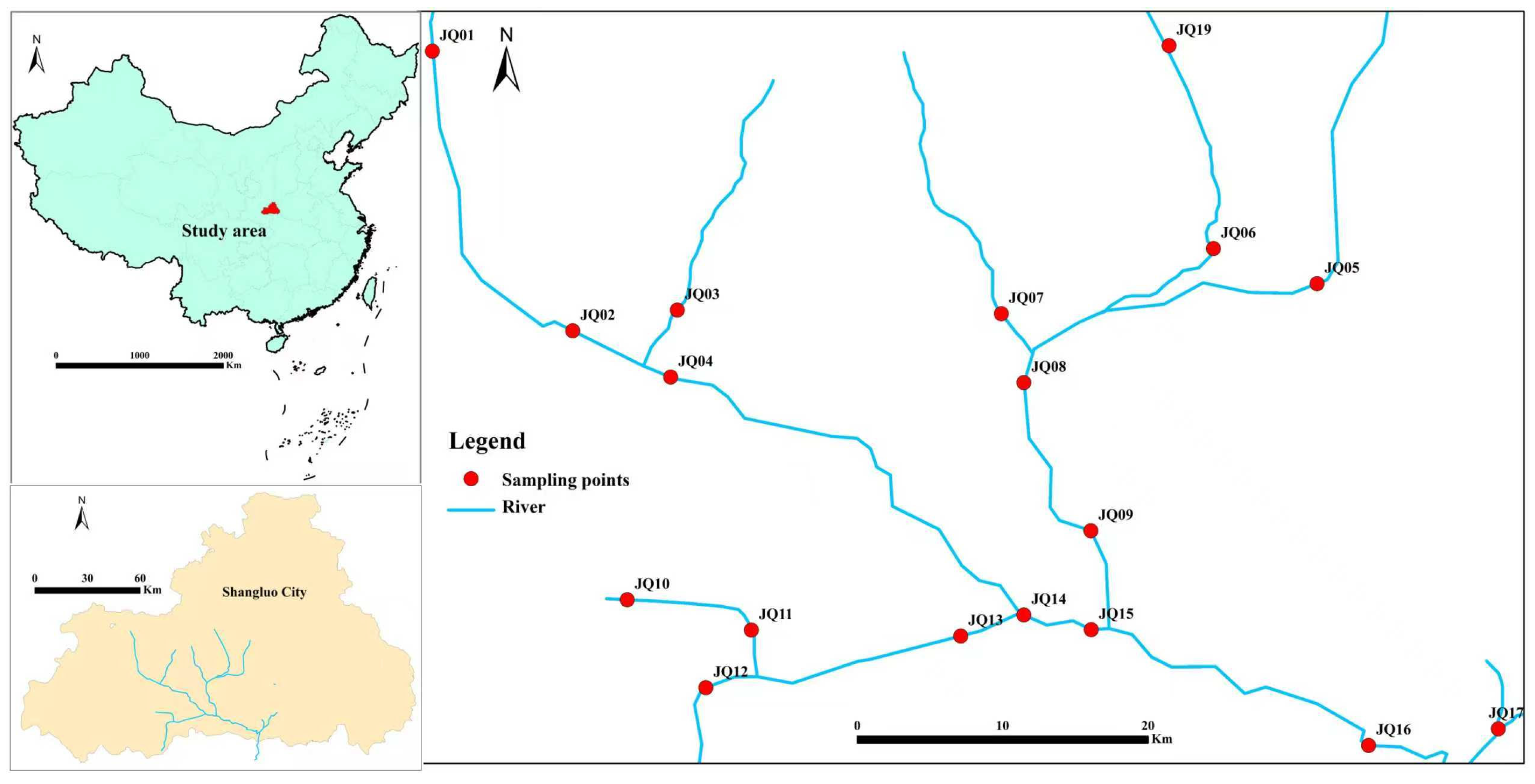
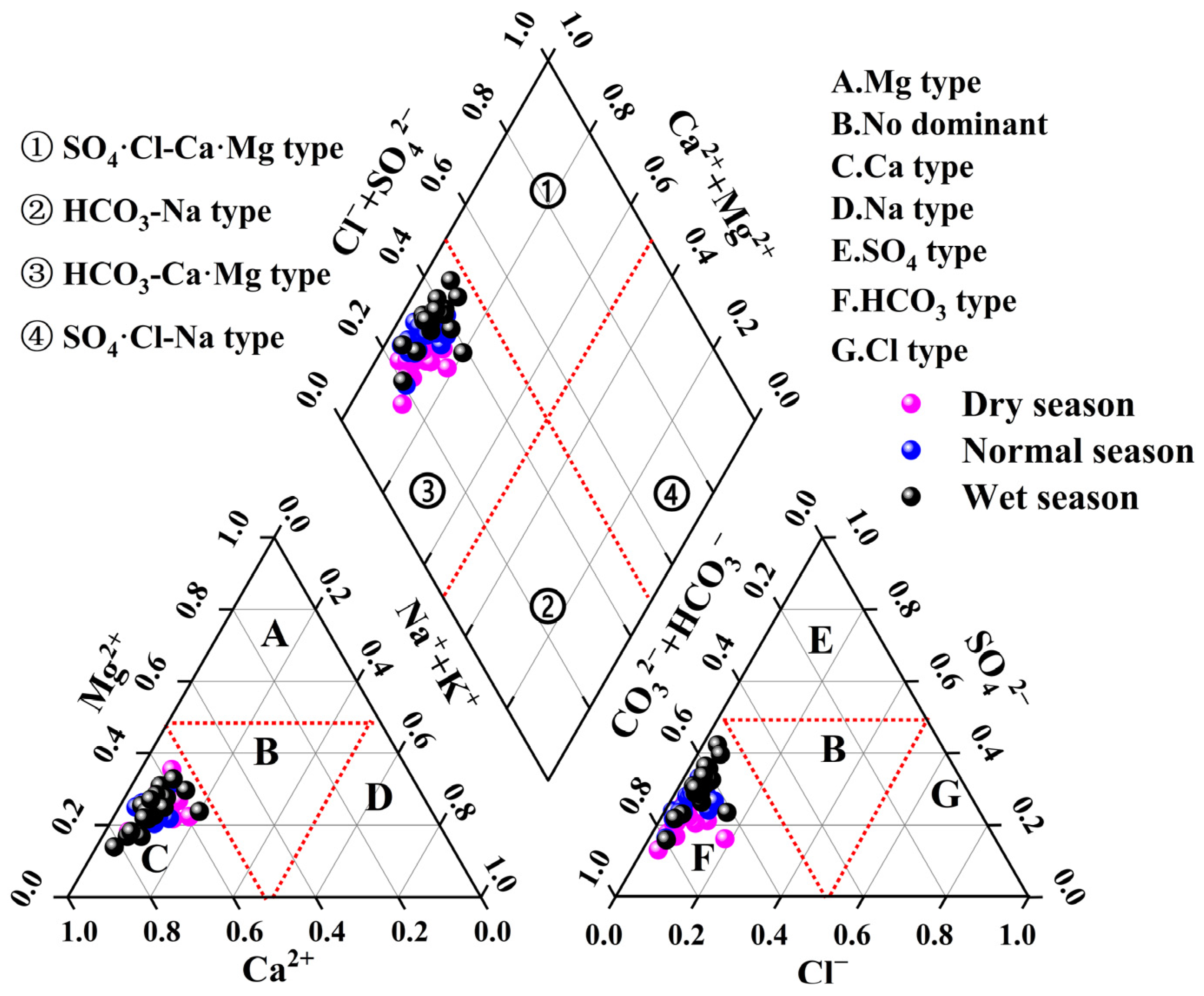
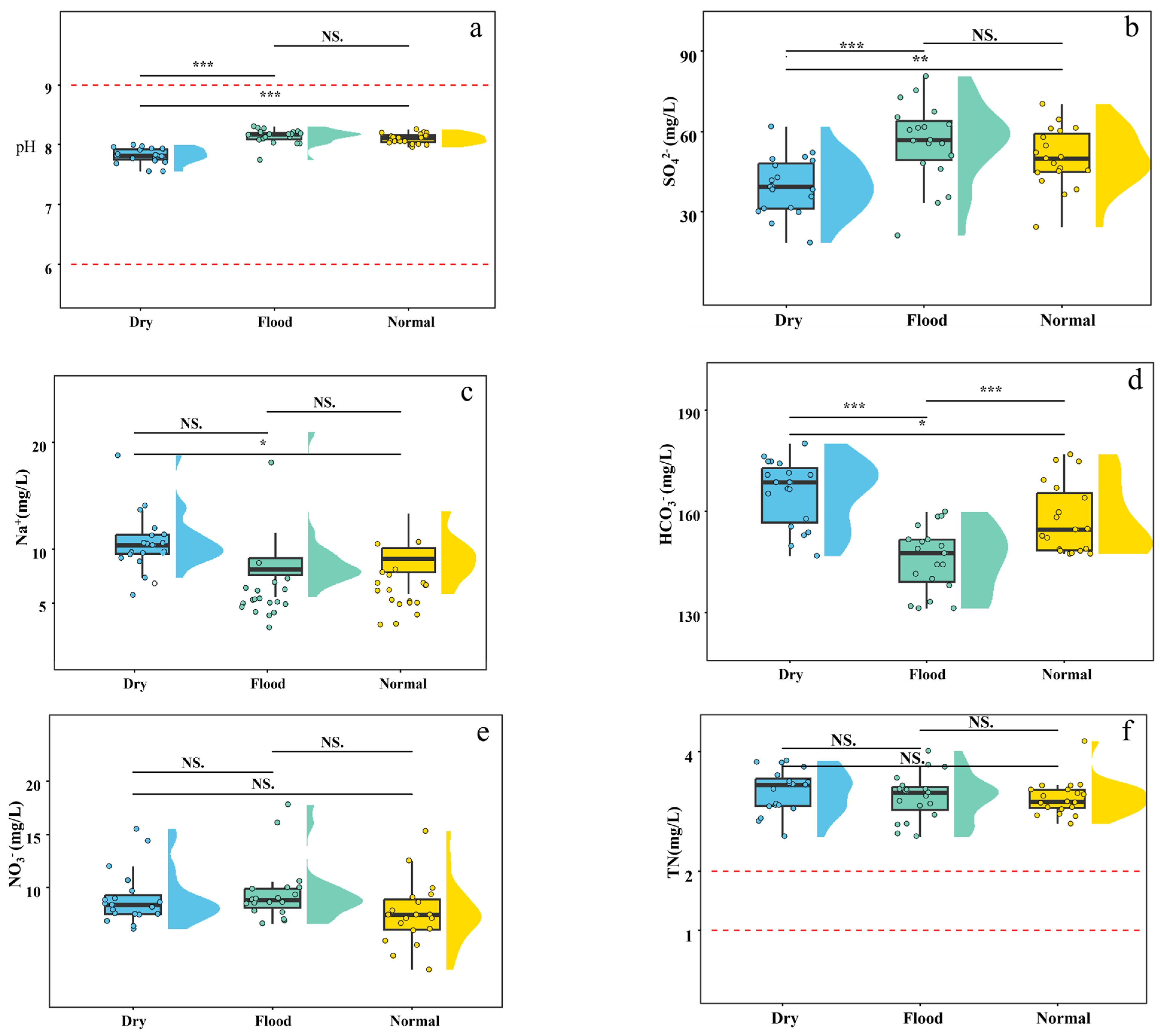
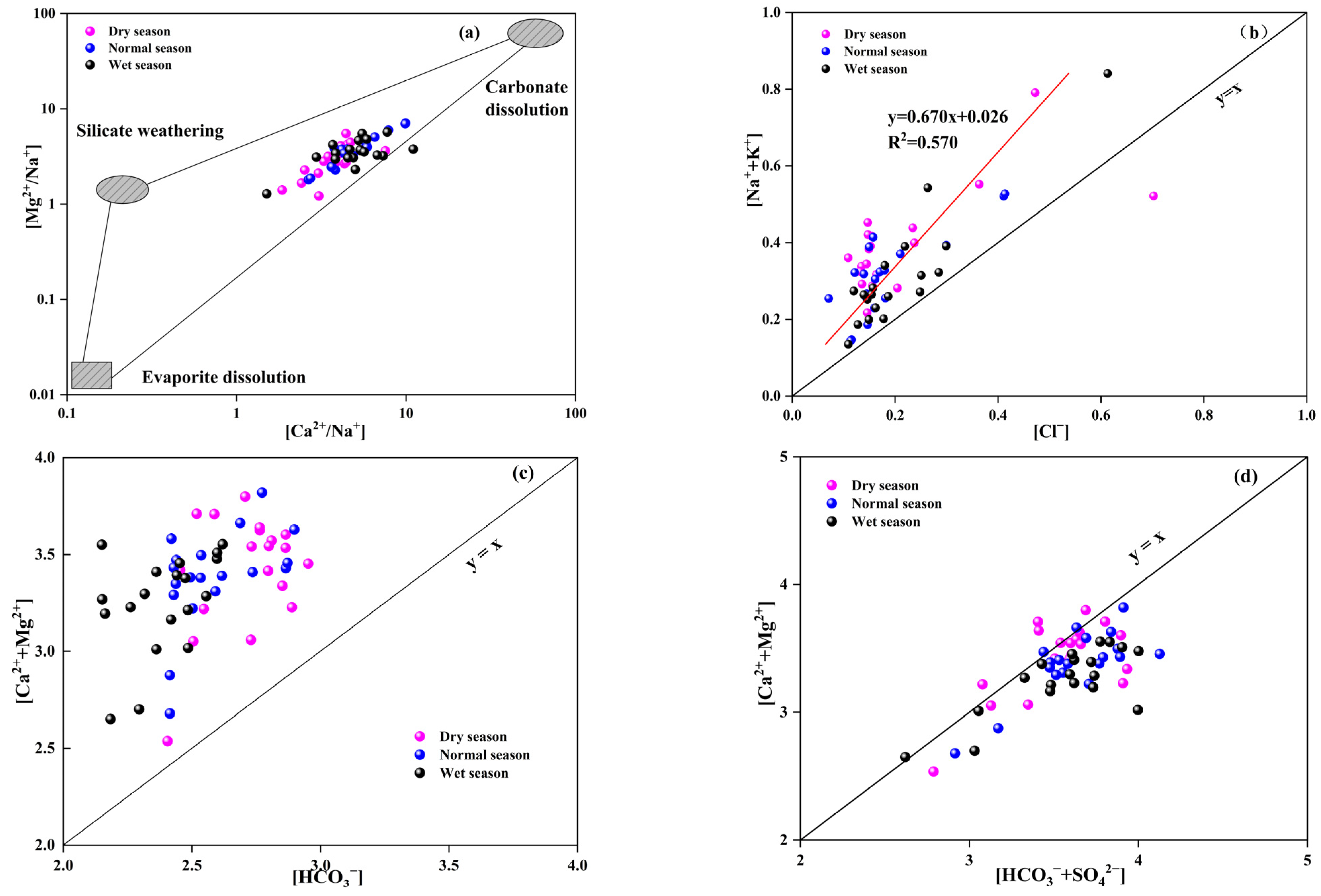
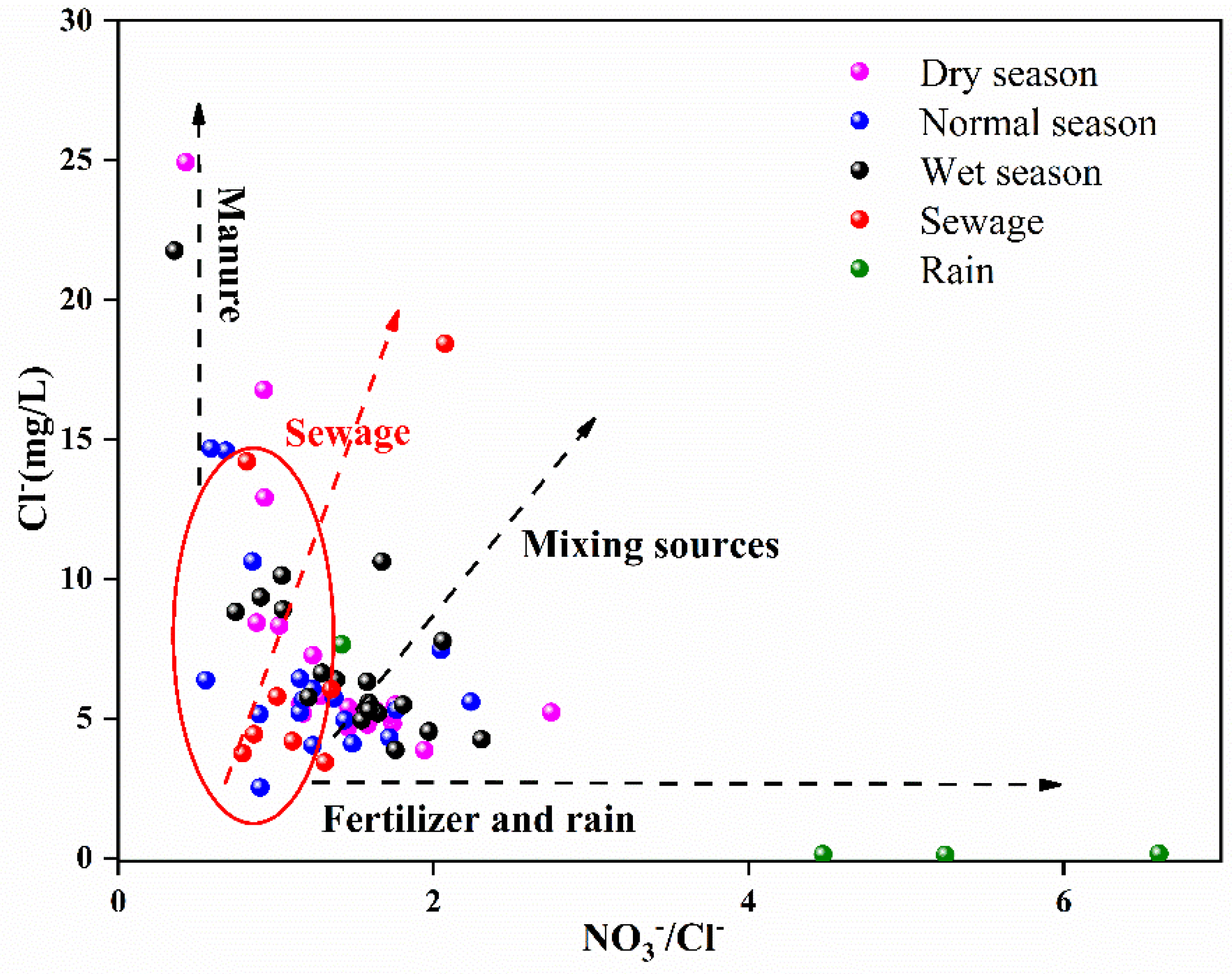
| Parameters | Units | Standard | Dry Season | Normal Season | Flood Season | ||||||
|---|---|---|---|---|---|---|---|---|---|---|---|
| Range | Mean | CV | Range | Mean | CV | Range | Mean | CV | |||
| pH | — | 6~9 | 7.55–7.99 | 7.81 | 1.61 | 7.96–8.25 | 8.10 | 1.00 | 7.74–8.3 | 8.13 | 1.51 |
| K+ | mg/L | 12 | 0.680–3.87 | 2.00 | 45.7 | 0.650–3.20 | 1.63 | 46.5 | 0.720–6.44 | 2.01 | 63.9 |
| Na+ | mg/L | 200 | 4.47–15.9 | 7.93 | 30.9 | 2.93–10.6 | 6.24 | 33.1 | 2.68–18.0 | 6.02 | 51.9 |
| Ca2+ | mg/L | 75 | 36.3–58.7 | 48.9 | 9.89 | 41.3–55.1 | 49.3 | 6.56 | 41.0–51.9 | 47.6 | 6.59 |
| Mg2+ | mg/L | 50 | 8.44–16.2 | 11.6 | 18.3 | 7.36–13.7 | 10.9 | 14.0 | 5.27–14.1 | 10.4 | 26.0 |
| Cl− | mg/L | ≤250 | 3.86–24.9 | 7.63 | 67.0 | 2.52–14.6 | 6.51 | 50.1 | 3.86–21.7 | 7.45 | 52.5 |
| SO42− | mg/L | ≤250 | 18.3–61.6 | 39.4 | 26.0 | 24.0–70.2 | 50.0 | 21.6 | 20.9–80.6 | 56.0 | 25.7 |
| HCO3− | mg/L | — | 146–180 | 165 | 5.78 | 147–176 | 157 | 6.43 | 131–159 | 145 | 6.37 |
| NO3− | mg/L | ≤44.3 | 6.07–15.4 | 8.98 | 27.3 | 2.27–15.2 | 7.54 | 38.7 | 6.56–17.7 | 9.45 | 29.3 |
| NH4+ | mg/L | ≤1.29 | 0.352–1.33 | 0.710 | 38.7 | 0.303–1.20 | 0.720 | 36.7 | 0.280–1.36 | 0.620 | 49.8 |
| TN | mg/L | ≤1 | 2.56–3.84 | 3.32 | 10.6 | 2.79–4.18 | 3.22 | 9.09 | 2.56–4.01 | 3.23 | 11.6 |
| F− | mg/L | ≤1 | 0.893–1.12 | 0.990 | 6.59 | 0.399–1.34 | 0.810 | 33.6 | 0.599–2.26 | 1.02 | 38.2 |
| DOC | mg/L | — | 0.765–2.38 | 1.14 | 32.0 | 0.740–4.00 | 1.24 | 57.5 | 0.700–3.23 | 1.31 | 44.9 |
| TDS | mg/L | ≤1000 | 160–357 | 275 | 16.6 | 169–349 | 278 | 15.1 | 160–357 | 249 | 16.6 |
| Water Quality Level | Comprehensive Water Quality Score | Proportion of Sites in 3 Periods (%) | ||
|---|---|---|---|---|
| Dry Season | Normal Season | Flood Season | ||
| Excellent water | <50 | 0 | 0 | 0 |
| Good water | 50–100 | 100 | 94.7 | 89.5 |
| Poor water | 100.1–200 | 0 | 5.26 | 10.5 |
| Very poor water | 200.1–300 | 0 | 0 | 0 |
| Water unsuitable for drinking purposes | >300 | 0 | 0 | 0 |
| Parameters | PC1 | PC2 | PC3 | PC4 |
|---|---|---|---|---|
| Na+ | 0.877 | 0.031 | 0.156 | 0.233 |
| Cl− | 0.843 | −0.204 | 0.091 | 0.020 |
| F− | 0.809 | −0.151 | 0.021 | −0.234 |
| K+ | 0.808 | 0.370 | −0.149 | −0.053 |
| NO3− | 0.803 | 0.434 | −0.085 | 0.245 |
| SO42− | 0.031 | 0.838 | 0.185 | −0.109 |
| Ca2+ | 0.101 | 0.823 | 0.015 | 0.044 |
| Mg2+ | −0.053 | −0.002 | 0.830 | −0.213 |
| TDS | 0.055 | 0.594 | 0.704 | 0.056 |
| HCO3− | −0.157 | 0.120 | 0.672 | 0.467 |
| DOC | 0.206 | −0.593 | −0.635 | −0.003 |
| TN | 0.364 | −0.136 | −0.109 | 0.883 |
| NH4+ | 0.214 | −0.104 | −0.180 | 0.692 |
| Eigenvalue | 3.59 | 2.52 | 2.18 | 1.50 |
| Contribution Rate (%) | 27.6 | 19.4 | 17.8 | 15.1 |
| Cumulative Contribution Rate (%) | 27.6 | 47.0 | 64.8 | 79.9 |
Disclaimer/Publisher’s Note: The statements, opinions and data contained in all publications are solely those of the individual author(s) and contributor(s) and not of MDPI and/or the editor(s). MDPI and/or the editor(s) disclaim responsibility for any injury to people or property resulting from any ideas, methods, instructions or products referred to in the content. |
© 2025 by the authors. Licensee MDPI, Basel, Switzerland. This article is an open access article distributed under the terms and conditions of the Creative Commons Attribution (CC BY) license (https://creativecommons.org/licenses/by/4.0/).
Share and Cite
Yang, C.; Qu, Z.; Shi, X.; Yang, L.; Yang, N.; Yang, F.; Zhang, Q. Key Controlling Factors and Sources of Water Quality in Agricultural Rivers: A Study on the Water Source Area for the South-to-North Water Transfer Project. Water 2025, 17, 3111. https://doi.org/10.3390/w17213111
Yang C, Qu Z, Shi X, Yang L, Yang N, Yang F, Zhang Q. Key Controlling Factors and Sources of Water Quality in Agricultural Rivers: A Study on the Water Source Area for the South-to-North Water Transfer Project. Water. 2025; 17(21):3111. https://doi.org/10.3390/w17213111
Chicago/Turabian StyleYang, Congcong, Zeliang Qu, Xiaoyu Shi, Li Yang, Nan Yang, Fan Yang, and Qianqian Zhang. 2025. "Key Controlling Factors and Sources of Water Quality in Agricultural Rivers: A Study on the Water Source Area for the South-to-North Water Transfer Project" Water 17, no. 21: 3111. https://doi.org/10.3390/w17213111
APA StyleYang, C., Qu, Z., Shi, X., Yang, L., Yang, N., Yang, F., & Zhang, Q. (2025). Key Controlling Factors and Sources of Water Quality in Agricultural Rivers: A Study on the Water Source Area for the South-to-North Water Transfer Project. Water, 17(21), 3111. https://doi.org/10.3390/w17213111






